First-person shooters have been one of PC gaming's preeminent genres for about 10 years now, and those who've kept up with it over the years know that, for one thing, these games have gotten a lot more complicated. Whereas the early games that defined the genre gave you no incentive other than to blast your way from one end of a level to the other--or they had you blasting any other player that moved, in the case of their multiplayer modes--today's most-popular shooters feature complex team-based modes, deep narratives, and Hollywood-style trappings. Not Painkiller. This game is a throwback to the older classics. Specifically, it's a throwback to id Software's Quake, whose multiplayer deathmatch mode popularized an aggressively fast-paced style of play. Painkiller is a simple game at heart, but it's very well-put-together and does what it does exceedingly well. That is, it offers up lots of spectacularly visceral, bloody, in-your-face action through its numerous, action-packed single-player levels. And it looks beautiful, it sounds great, and it's got a pretty good old-school multiplayer deathmatch mode, for good measure. If you enjoyed the genre's pre-Half-Life classics or more-recent arcade shooters like Serious Sam, then you'll love Painkiller.
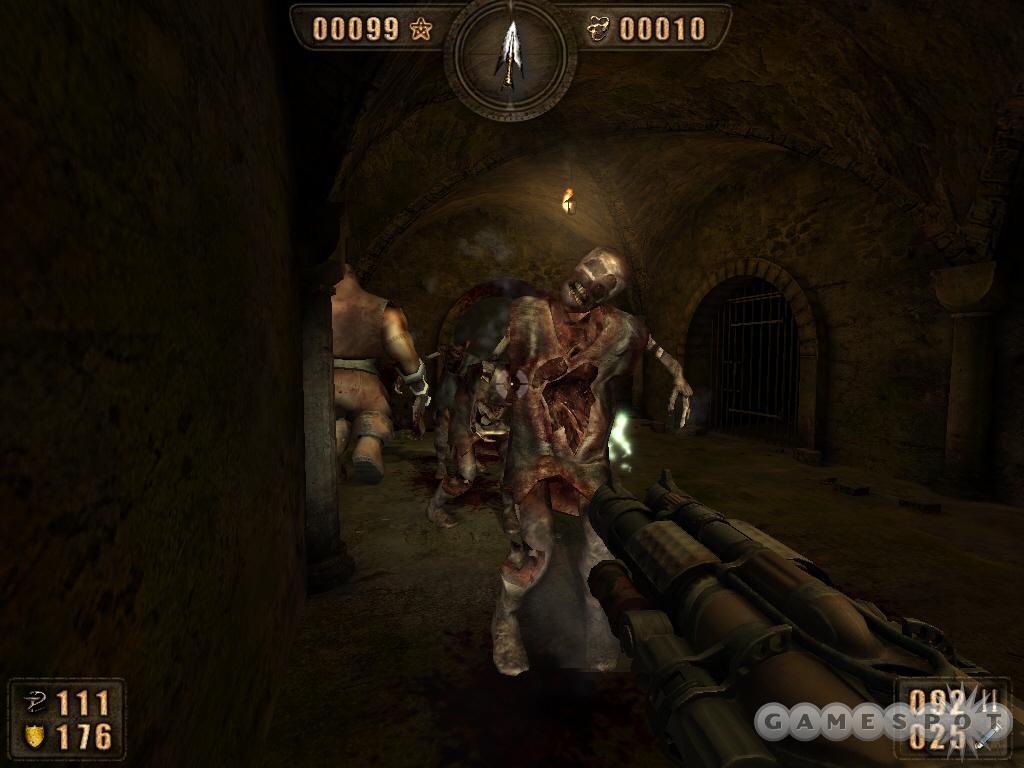
Painkiller does have a plot, which isn't evident and doesn't unfold at all during the actual levels, but it's presented in fairly unimpressive and surprisingly drawn-out cutscenes in between the game's five chapters. After dying in a car accident, Daniel Garner finds himself in purgatory, which is somewhere between heaven and hell. He's given a choice that's not much of a choice at all: The forces of hell are planning to wage war on heaven, and Garner must single-handedly head them off at the pass, while also setting his sights on the four generals of Lucifer's army. So Dan takes the job--lucky you. This means you get to kill lots and lots of monsters using some overpowered weapons, and, at the end of each chapter, you'll square off against a huge and towering boss monster.
Painkiller's two-dozen single-player levels offer no nonsense. Each level is self-contained and starts you off with full health and a limited amount of ammunition. Progress through the stages is basically linear, and an onscreen compass needle is there to (usually) always point you to where the enemies are or to where the next checkpoint is. What happens is, enemies materialize in your vicinity, some heavy metal music starts playing, and you start shooting--often while desperately trying to run away from your savage foes. Once the coast is clear, you can catch your breath, cross the next checkpoint, automatically regain all your health (at the default difficulty), and then repeat the process. This isn't complicated stuff--but that's not a bad thing at all.

This isn't the depiction of hell or purgatory that you might expect. Rather than have levels consisting of all flames, demons, and caverns, Painkiller consists of a wide variety of different themes. As a result, the game may have you blasting zombies and lunatic freaks in a haunted insane asylum in one level, battling ninjas and samurai in an opera house in another, gunning down weird biker-thugs in industrial complexes in the next, and then taking on knights and mad monks in a medieval castle after that. Remarkably, the eclectic variety of settings somehow ends up having a cohesive feel to it, and the variety itself is definitely to the game's credit. Though not all the game's enemies behave differently, it's great to encounter different types of foes in almost every stage, and the game just does a good job of keeping you guessing as to what sort of weird location you'll find yourself in next.
There are only five weapons in Painkiller, although each one has a completely different alternate firing mode, and each one is useful, so it's really closer to 10. For example, one of the weapons is both a rocket launcher and a chaingun, thus making it quite possibly the most versatile and powerful gun in first-person-shooter history. Most of the weapons also have a unique effect for when you combine the primary and alternate firing modes. For instance, the combination double-barreled shotgun/freeze ray can be used to immobilize and then shatter enemies. You never need to manually reload, and, like in the original Quake and other, older shooters, there isn't even an animation for weapon-switching. One gun just vanishes, and the next one appears, allowing you to readily cycle through all your weapons as needed, even in the middle of a hectic battle. Also, due to the generous use of checkpoints, you pretty much never even need to stop to quicksave, though you can do so if you wish. In the end, it's not difficult to blast through most any of the game's levels in 20 minutes or fewer. It's still a good amount of single-player content overall.
Ironically, despite the straightforwardness of the core action, the game's bosses are all quite tricky and are difficult to defeat. Not only are they big and scary, but you'll need to find their weak points, which isn't easy. The bosses are impressively huge and really aren't as unfair to fight as they might initially seem, so they make for great set pieces in between multiple levels of manic action. Unless you reached the end of Serious Sam, it's safe to say you've never seen first-person shooter bosses as big and impressive as these.
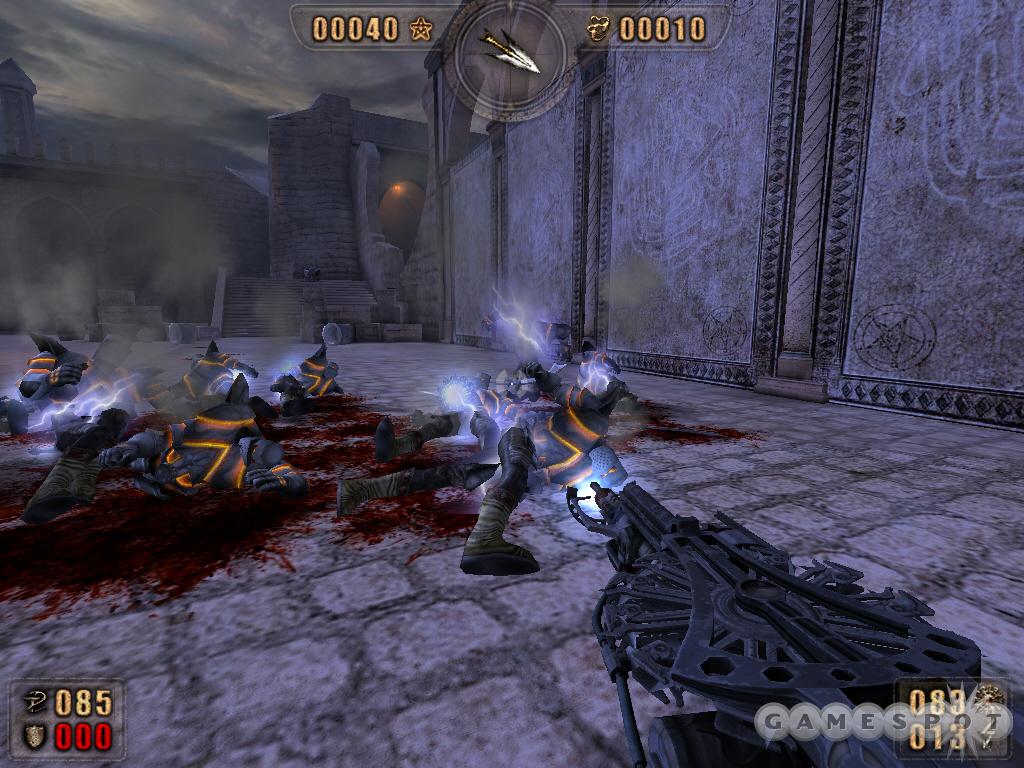
The thing about Painkiller is that its combat just has a great feel to it. And if a shooter is going to accomplish one and only one task, this is the one to nail down. Most notably, Painkiller features the most-impressive use of realistic physics in a game to date. Some other recent games have begun incorporating physics, which results in enemies that can be sent flying backward when hit, in addition to boxes and barrels that can be knocked around accordingly. However, Painkiller does all this better. Background objects explode when hit, sending shards of debris every which way or causing major chain reactions. Enemies get flung far and wide from the explosive blasts of your rocket launcher. The game's most memorable weapon, the stakegun, fires slow-loading, deadly wooden stakes that slam into their victims with intense force, often pinning them to nearby walls where they'll hang limply--dead.
Enemies don't just flop around like rag dolls, though. A close-range shotgun blast or close contact with an explosive (say, a convenient stack of exploding barrels) will cause your foes to erupt in a shower of smoldering, bloody parts, which is an effect that's as grisly as it is satisfying. Another great touch is that enemies will even let go of their weapons when hit. You'll be thrilled to blow up huge bunches of bad guys to watch as all their guns or swords blast off into the distance, while large pools of gore, all littered with bullet holes and scorched earth, mark your passing. Body counts rack up high. The game's enemies aren't very complicated to fight, but since you'll routinely take on both fast-moving close-combat foes and ranged attackers at the same time, the action can be pretty tactical and consistently intense. But again, above all, it's gratifying.
Painkiller does have a few twists. A few moments after enemies are killed, they disappear in a puff of smoke and leave behind a swirling green "soul," which you can collect to regain just a single point of health (some enemies leave behind bad souls that actually hurt you). Still, with body counts like these, the extra health can add up. More importantly, after picking up enough souls, you'll briefly and automatically transform into a fast-moving, invincible demon that can devastate any enemies in the vicinity. It's a nice effect, because the scenery all turns black and white, but enemies stand out in blood red.
Furthermore, you'll collect coins in each level, which can be found as you destroy treasure chests or other such objects, and these can be used to select what are called "black tarot cards" before each level. These cards must first be unlocked by fulfilling certain conditions in each level (say, by only using a particular weapon, killing every single foe, or collecting a certain number of souls). Basically, they grant certain bonuses that can give you the edge in the next level. The effects stack, too. So, for instance, you can combine card effects that cause you to move ultrafast with card effects that cause everything else to slow down. This results in some Max Payne-style bullet time. Yet while the black tarot feature is interesting, it's also somewhat extraneous, so it can safely be ignored if you want to play Painkiller in its purest form.
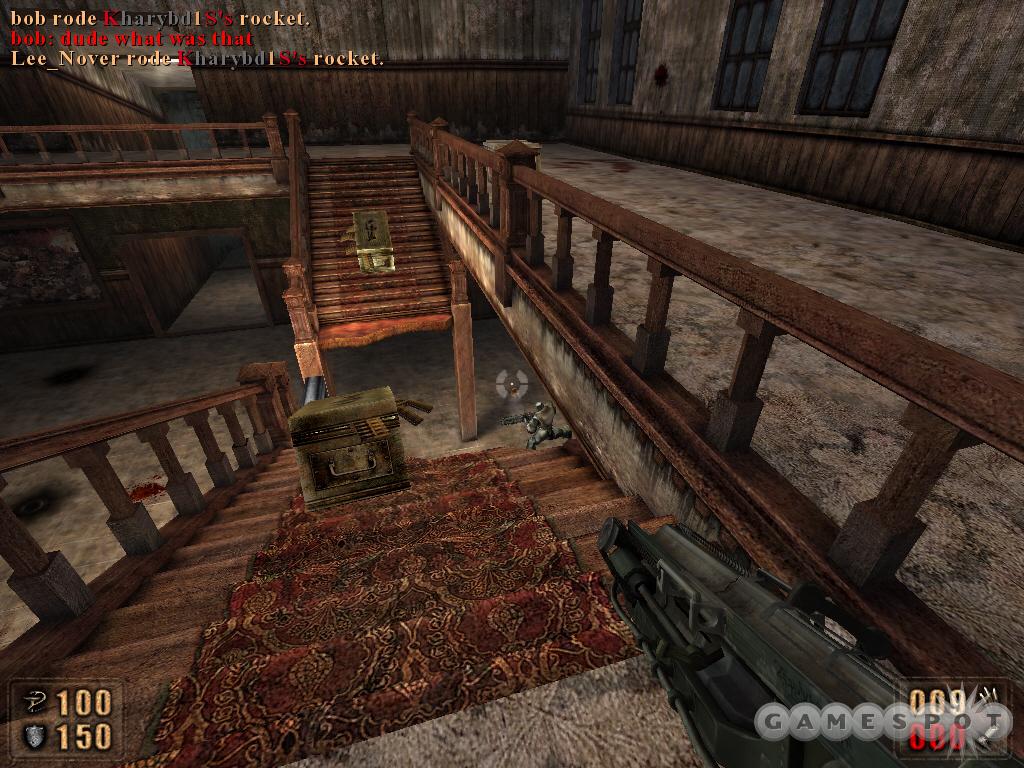
Speaking of pure... Multiplayer Painkiller is a throwback to the days of the original Quake. Indeed, the fast-moving pace and the rapid-fire, no-reload feel of all the weapons seem like they were lifted straight from id Software's game. Painkiller's multiplayer mode works fine and, thankfully, features a built-in server browser (unlike Quake), thus allowing you to jump into an online match. However, modes of play are limited to variations on deathmatching, and there's just a small selection of maps, most of which start to feel crowded with only around eight players in them, though 16-player games are possible. There's a free-for-all mode, a team deathmatch mode, and a few others: The best is called "voosh," and in it, all players are automatically equipped with the same weapon and unlimited ammo...but only for a short period of time, at which point they randomly get a new weapon. Meanwhile, the "light bearer" mode is like a bloody variation on the game of tag. There's a quad-damage power-up somewhere in the level, and once someone picks it up, the effects don't wear off, so that player gets to go on a rampage. Presumably, other players should concentrate on taking the overpowered player out so that they can relieve his or her corpse of the power-up to carry on the legacy.
Finally, the "people can fly" mode, named after the Poland-based developer of the game, is set in cylindrical stages where everyone's got a high-powered rocket launcher with unlimited ammo. The thing is, you can only score kills on airborne opponents, so what ensues is a completely insane match where you're constantly getting blasted into the air while constantly trying to draw a bead on the other players who are bouncing around.
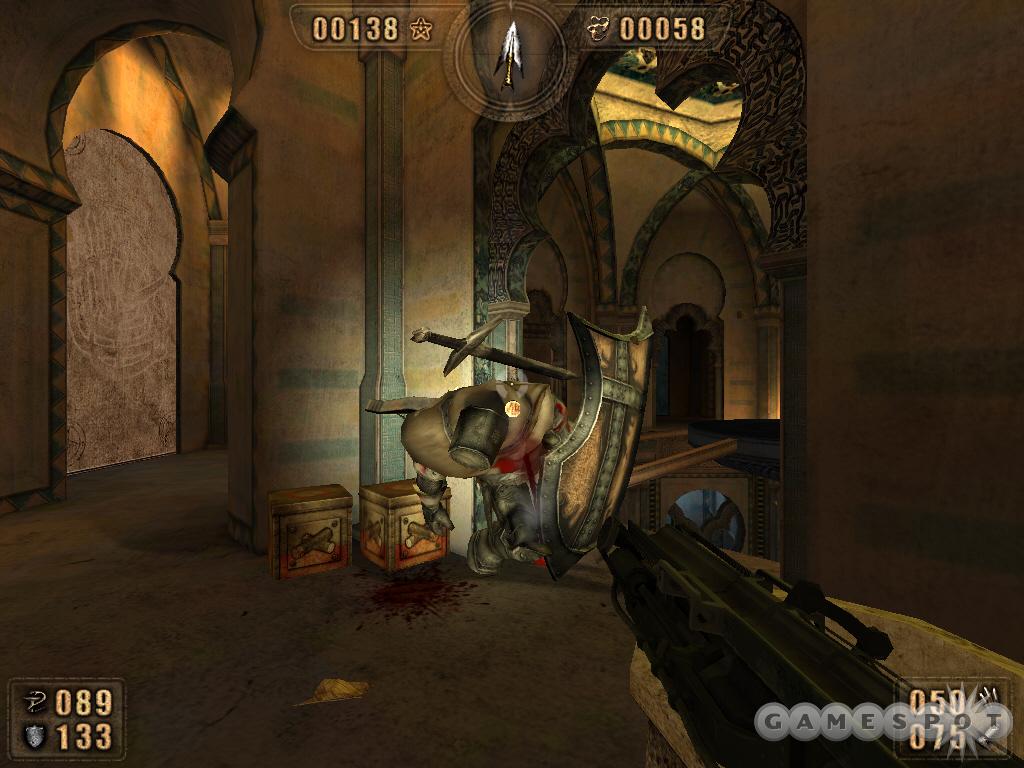
Anyway, Painkiller's deathmatching is pretty good, though some of the weapons aren't very well suited for it. You always spawn in with the default "painkiller" weapon, which is actually quite effective, as well as the stakegun, which isn't. The stakegun may seem similar to instant-hit-type weapons from other games, such as railguns or sniper rifles, but its projectile travels quickly in a parabolic arc rather than instantly hitting whatever's in the middle of your targeting reticle, so therefore it can't be used to easily hit fast-moving targets, like the players you'll be up against. It's certainly satisfying to score a lethal hit with a stake in multiplayer, but it's also probably the least-effective way to get the job done. Meanwhile, the combination lightning gun/throwing star-launcher weapon has a combo attack that electrifies everything in the vicinity, so it can easily be used to score a bunch of cheap kills. And, in the light bearer mode, the rocket launcher/chaingun is pretty much ridiculous. In fact, it'll blow you to bits if you so much as look at it wrong.
There are a few minor issues worth mentioning about Painkiller. The default difficulty setting is actually a little on the easy side for veteran first-person-shooter players, who certainly are among the game's target audience, so they should cut straight to the more-challenging settings. Also, the game drops you back to the level-select menu in between each scenario, as if to invite you to take a breather rather than letting you dive right into the next fight. It's not really a bad thing, but it's a little disruptive. It would have been nice if the main menu had a "continue" option, but instead, you'll need to dig up your autosave file whenever you come back to the game to continue playing. Painkiller's loading times also aren't that great. You can quicksave your progress instantly, but if you die during a level, you can't just instantly pop back in. Furthermore, while it's nice that the game's levels are so clear-cut, occasionally the compass stops working, which results in time spent wandering around with no one to shoot. Of course, this is anticlimactic. Finally, for a game that clearly takes inspiration from Serious Sam, it's disappointing that Painkiller lacks that game's outstanding cooperative mode. It would have been a real blast to be able to run around this game's levels with a few other players, and there's nothing about the game design that seems to suggest that this wouldn't be practical.
Painkiller uses People Can Fly's proprietary 3D engine, which is gorgeous and runs smoothly with all the details turned on--if you have a computer setup that meets the recommended system requirements. Environments are richly detailed and pack plenty of stuff that can be blown up or otherwise destroyed, and enemies are great-looking, nicely animated, and varied. Your vision temporarily blurs when you take a hit, which is a good effect, and as mentioned, the gore effects are sublime. The game runs well even when tons of enemies are trying to kill you or when the 100-foot-tall boss you're fighting happens to destroy the entire floor you're standing on, sending you tumbling several stories down. It's not all this over-the-top, though. Some of the levels are really creepy, instead, and take place predominantly in darkness, illuminated only by a flickering flashlight on your weapon (which must be manually toggled on in each level, for some reason).
Painkiller sounds great, too. Its enemies can all be heard shouting angrily and unintelligibly, yet in a manner that's unmistakably threatening, thus creating a cacophony that seems decidedly appropriate. Explosions and weapon effects are spot-on, though the limited number of weapons and the sheer amount of shooting to be done means you'll soon grow familiar with the sound of each gun. The heavy-metal soundtrack also fits the game just right. It's like you're playing a game based on an Iron Maiden album cover.
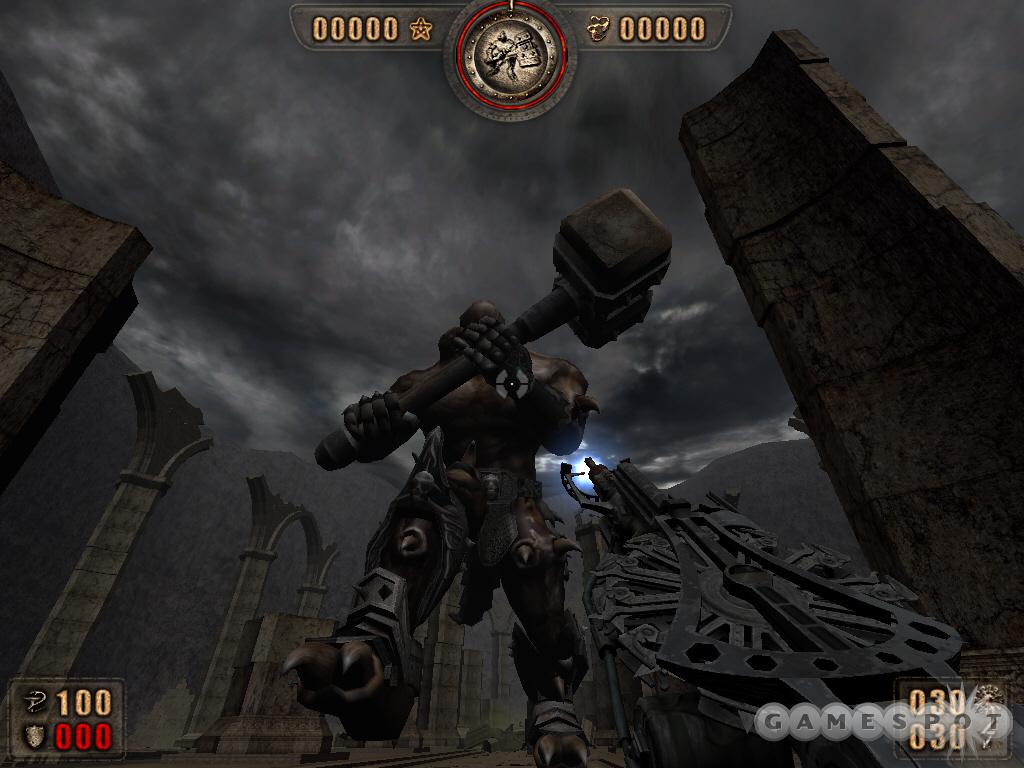
Shooters are supposed to be fun, and depending on your personal definition of what makes a game fun, Painkiller can potentially offer you a whole lot of it. This is a superb-looking game that plays fast and has plenty of thrilling, unscripted moments that result from the calamity you can cause with your otherworldly weapons. The game is drenched in blood and is filled with ugly, nasty enemies that make for great targets, and its bosses are tough and undeniably impressive. The multiplayer mode can be a blast too--if you prefer the simpler days of competitive first-person shooting, which you have every right to, since some of today's online shooters are decidedly more-complicated than is probably necessary. At any rate, Painkiller's a winner and a keeper. There've been an undue number of impressive shooters already this year, but don't let that keep your attention away from this one. It's well worth your while, and it's a commendable first effort from what's clearly a talented, new developer.